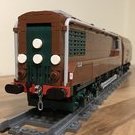
[OcTRAINber MOC] LMS Articulated Railcar (1938)
By
Hod Carrier, in LEGO Train Tech
-
Recently Browsing 0 members
No registered users viewing this page.

By
Hod Carrier, in LEGO Train Tech
No registered users viewing this page.